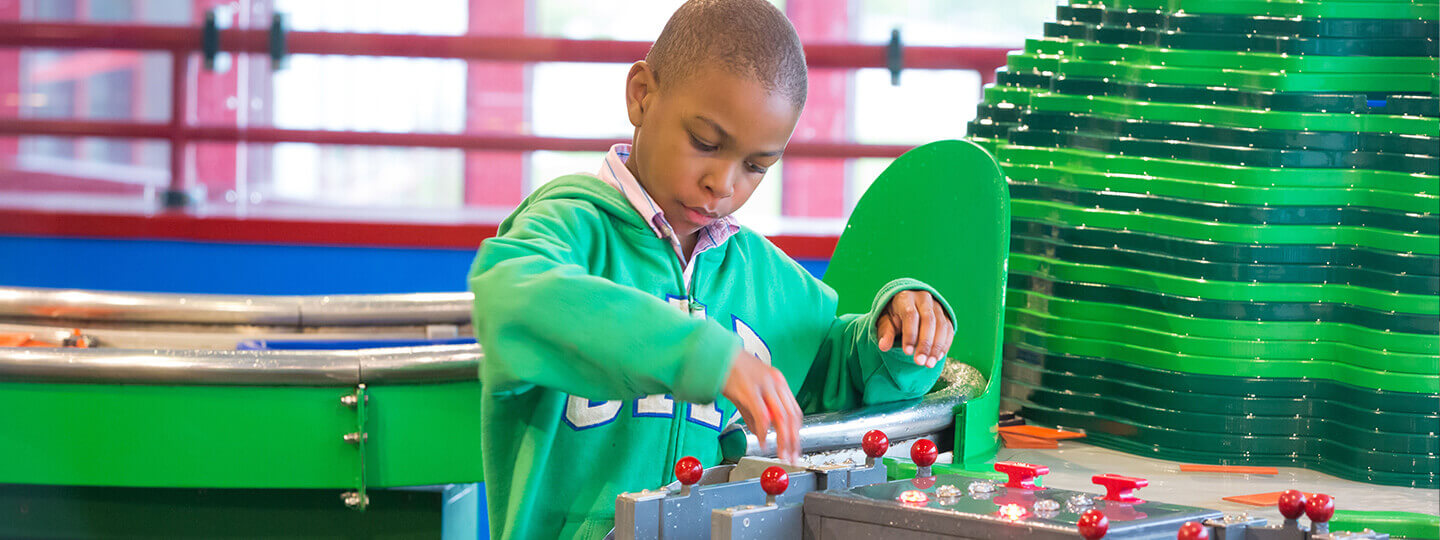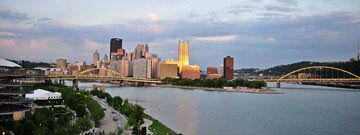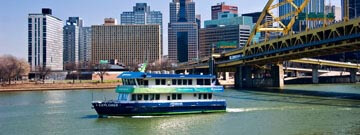

Presented by:
![]()
H2Oh!
Oh!-verview
- Where do our rivers come from and where are they going?
- What lives in these waters, nests in these banks, and grows on these shores?
- What impact does my community have on the river? What impact does my family have? What impact do I have – personally, (and, for the next generation of Pittsburghers), through my choices?
Children and adults alike will enjoy taking in the spectacular view of the dramatic confluence of Pittsburgh's three rivers (Monongahela, Allegheny, and Ohio) from the exhibit gallery with newfound appreciation for our waterways and an understanding of why we all need to conserve water.
Pittsburgh's freshwater rivers are so ubiquitously integrated with the cityscape that it's easy to forget what a precious resource they are and have been historically. With growing populations and the increasing pressures of development, the world is facing a critical water shortage. About 1 in 8 people globally are without clean drinking water. That's something to keep in mind if you have a hard time remembering to turn off the faucet while brushing your teeth!
Even in the United States, demand is greater than supply. Americans consume or use, on average, 150 gallons of water a day. This is compared to 40 gallons in the UK and 22 gallons in China. In the coming years, 36 states will face water shortages. Visitors may also be surprised to learn about the less conventional means in which we use water. Approximately one gallon of water is used to create one 12-oz. plastic bottle of water!
Guests will have the opportunity to learn all about water science and why our rivers matter as they explore The Environment and Conservation, Fluid Dynamics, and the Field Station exhibits!
Careers in Water Science – Do you love learning about our waterways? Then you should explore a career as a water scientist! There are many exciting sub-disciplines of water science. Biologists, physicists, and chemists alike unite to create a better understanding of our waterways. Understanding the science, understanding the issues, and understanding the technologies—available and emerging—will help our region be better prepared for the challenges and opportunities ahead. Water scientists are needed in federal, state, and city governments, as well as private industries and academic institutions. Check out the regional resources page for more information!
This exhibit, located in the Covestro Gallery, is presented by The Colcom Foundation and also supported by:
- The Fisher Fund of The Pittsburgh Foundation in Memory of James A. Fisher
- Laurel Foundation
- Dollar Bank
- Peoples Gas
H2Oh!
Oh!-verview
- Where do our rivers come from and where are they going?
- What lives in these waters, nests in these banks, and grows on these shores?
- What impact does my community have on the river? What impact does my family have? What impact do I have – personally, (and, for the next generation of Pittsburghers), through my choices?
Children and adults alike will enjoy taking in the spectacular view of the dramatic confluence of Pittsburgh's three rivers (Monongahela, Allegheny, and Ohio) from the exhibit gallery with newfound appreciation for our waterways and an understanding of why we all need to conserve water.
Pittsburgh's freshwater rivers are so ubiquitously integrated with the cityscape that it's easy to forget what a precious resource they are and have been historically. With growing populations and the increasing pressures of development, the world is facing a critical water shortage. About 1 in 8 people globally are without clean drinking water. That's something to keep in mind if you have a hard time remembering to turn off the faucet while brushing your teeth!
Even in the United States, demand is greater than supply. Americans consume or use, on average, 150 gallons of water a day. This is compared to 40 gallons in the UK and 22 gallons in China. In the coming years, 36 states will face water shortages. Visitors may also be surprised to learn about the less conventional means in which we use water. Approximately one gallon of water is used to create one 12-oz. plastic bottle of water!
Guests will have the opportunity to learn all about water science and why our rivers matter as they explore The Environment and Conservation, Fluid Dynamics, and the Field Station exhibits!
Careers in Water Science – Do you love learning about our waterways? Then you should explore a career as a water scientist! There are many exciting sub-disciplines of water science. Biologists, physicists, and chemists alike unite to create a better understanding of our waterways. Understanding the science, understanding the issues, and understanding the technologies—available and emerging—will help our region be better prepared for the challenges and opportunities ahead. Water scientists are needed in federal, state, and city governments, as well as private industries and academic institutions. Check out the regional resources page for more information!
This exhibit, located in the Covestro Gallery, is presented by The Colcom Foundation and also supported by:
- The Fisher Fund of The Pittsburgh Foundation in Memory of James A. Fisher
- Laurel Foundation
- Dollar Bank
- Peoples Gas
Presented by:
![]()







